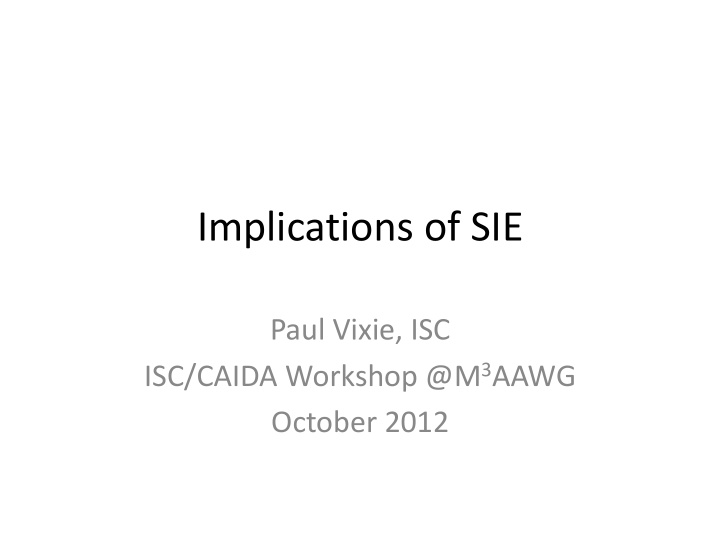



Implications of SIE Paul Vixie, ISC ISC/CAIDA Workshop @M 3 AAWG October 2012
SIE Characteristics • History: conceived in 2007, piloted in 2008 (NCAP), formally launched in ~2009 (NMSG) • General purpose, scalable, distributed data collection; shared real-time analysis • Multiple channels, multiple schemas • Channels: passive DNS, honeypot results, spamtrap results, network telescope packets • Growth (traffic, sensors, data types) continues
Known SIE Applications • First blood goes to Andrew Fried, who cross- correlated passive DNS and spam trap results • ISC DNS channel package (dedup, filtering) • ISC DNSDB is a general purpose passive DNS database – ~2 years so far, fully indexed • Some security companies are feeding SIE data into their pre-existing analysis systems • Many SIE credits in published research
An Impedence Mismatch? • Noting: – Science requires objective repeatability – SIE is like Heraclitus’ river: never the same • Open questions: – Does academic rigor require known data sets? – Would that hold back innovation of real-time analysis methods?
ISC Passive DNS Channel Package • Raw sensor data is mightily self-similar – ISC’s dedup processes reduce by ~15:1 • Lots of chaff among the wheat – ISC’s filter separates the RBL, PTR, netflix, and DNS tunnel traffic into a “DNS c haff channel” – The remaining wheat gets its own channel • Note: NXDOMAIN, REFUSED, FORMERR, other errors, are only present in the raw data – ISC will shortly add a “DNS Error channel”
ISC’s Attitude Toward SIE • The SIE port and all raw sensor data donated to ISC is a service of ISC’s non -profit parent company – This is our deal with our sensor operators • Private raw sensor data (“proprietary spam”?) is available by negotiation with channel manager – SIE is a convenient and trusted place to interchange • ISC’s commercial value -added activities include: – “DNS channel p ackage” ( dedup, chaff filter, [errors]) – “DNSDB” (passive DNS database: full indexing forever)
ISC’s Corporate Structure • ISC’s heart and soul is a non -profit tax-exempt public charity – “the parent/holding company” – Operates Security Information Exchange (ISC SIE) • ISC deploys commercial subsidiaries for non- charitable activities – for fund-raising and to ensure relevance in the I.T. market – Value added security products (like DNSDB) – Also BIND/DHCP support, training, consulting, software enhancement; open source routing; etc.
Some Service Ideas • Anyone with an SIE port can build services – For themselves, or as a [commercial] service • ISC has a commercial subsidiary which is now in the process of building these examples – Commercial, so, not open-source – As with DNS channel package and DNSDB, price is reduced for sensor operators and poor non-profits • These are straightforward applications of SIE, presented here to stimulate some discussion
Service Idea #1: Real Time Monitoring • A network owner (“the customer”) registers: – Their global identifiers (IP addresses, DNS names) – Notification preferences (RSS, e-mail, SNMP trap) • The real time monitoring system watches for: – Spam or darknet from, or new passive DNS results in, customer IP address blocks – Spam mentioning, or passive DNS results about, customer domain or subdomain names
Service Idea #2: DNS Poisoning Detection • Customer registers: – The names of their DNS primary zones – Notification preferences (RSS, e-mail, SNMP trap) • Service operation: – Run a stealth DNS slave for all customer zones – Passive DNS results using any customer domain name are resolved in parallel inside stealth slave – Trigger if observed response is “wrong”
Discussion • We need new ideas in at least these areas: – Channels, sensors, data types – Gateways, translators, tools – [Commercial] services – SIE-enabled research • Discuss!
Recommend
More recommend